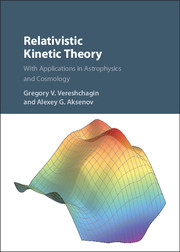Book contents
- Frontmatter
- Contents
- Preface
- Acknowledgments
- Acronyms and Definitions
- Introduction
- Part I Theoretical Foundations
- Part II Numerical Methods
- Part III Applications
- Appendix A Hydrodynamic Equations in Orthogonal Curvilinear Coordinates
- Appendix B Collision Integrals in Electron-Positron Plasma
- Appendix C Collision Integrals for Weak Interactions
- Bibliography
- Index
Introduction
Published online by Cambridge University Press: 09 March 2017
- Frontmatter
- Contents
- Preface
- Acknowledgments
- Acronyms and Definitions
- Introduction
- Part I Theoretical Foundations
- Part II Numerical Methods
- Part III Applications
- Appendix A Hydrodynamic Equations in Orthogonal Curvilinear Coordinates
- Appendix B Collision Integrals in Electron-Positron Plasma
- Appendix C Collision Integrals for Weak Interactions
- Bibliography
- Index
Summary
This book presents the subject of relativistic kinetic theory (KT). It starts from fundamental concepts and ideas and arrives at a vast spectrum of applications through the bridge of various numerical methods. It is not by chance that we adopted such an approach. KT of gases is perhaps the most fundamental theory in the classical (nonquantum) domain. It has been developed with the goal to derive the properties of matter at the macroscopic level, which is accessible to direct experiments and observations, based on the study of properties of microscopic particles and their mutual interactions, to which one has no direct access. The atomic picture of the world has emerged in this way. Indeed, KT was born in the nineteenth century, the golden age of classical physics. Based on the atomic picture [1], such properties as heat and electrical conductivity as well as viscosity and diffusion found natural explanations. The term originates from the Greek, where κινησις means “motion.” In fact, all the properties of the medium may be understood from the analysis of its microscopical structure and motions.
Nowadays KT has to be considered in a wider context of statistical mechanics, which appeared at the end of the nineteenth century, essentially in the works of Maxwell, Boltzmann, and Gibbs. It should be emphasized that the ideas and principles of KT influenced the development of many other branches of science, including mathematics (probability theory, ergodic theory), biology (evolutionary biology, population genetics), and economics (financial markets, econophysics). Within physics, KT is closely related to statistical physics, thermodynamics, and hydro- and gasdynamics. Today one can say that the main task of kinetic theory is the explanation of various macroscopic properties of a medium based on known microscopic properties and interactions. In a general context, KT is a theory of nonequilibrium systems. Indeed, all the above-mentioned fields of physics assume that the medium is in its most probable microphysical state, called equilibrium. Clearly, any macroscopic manifestation of deviations from this microscopic equilibrium should be considered within KT. Because basic phenomena in the microworld are described in a quantum language, KT uses extensively quantum theory. In fact, the basic principles and equations of KT may be derived from quantum field theory [2].
- Type
- Chapter
- Information
- Relativistic Kinetic TheoryWith Applications in Astrophysics and Cosmology, pp. 1 - 6Publisher: Cambridge University PressPrint publication year: 2017



